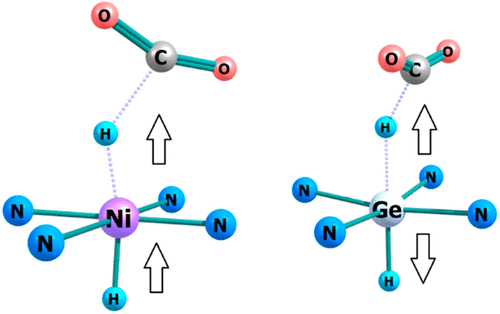当前位置:
X-MOL 学术
›
Inorg. Chem.
›
论文详情
Our official English website, www.x-mol.net, welcomes your feedback! (Note: you will need to create a separate account there.)
Trans Element-Hydrogen Bonds: A Distinctive Difference Between Transition Metals and Main Group Elements
Inorganic Chemistry ( IF 4.6 ) Pub Date : 2021-07-22 , DOI: 10.1021/acs.inorgchem.1c00801 Brian T H Tsui 1 , Robert H Morris 1
Inorganic Chemistry ( IF 4.6 ) Pub Date : 2021-07-22 , DOI: 10.1021/acs.inorgchem.1c00801 Brian T H Tsui 1 , Robert H Morris 1
Affiliation

|
The change in sign of the interaction force constant between element-hydrogen stretching modes of trans-dihydrides of the d block and p block elements is analyzed for the first time. As the transition metal M approaches group 12, the higher energy symmetric trans-H–M–H vibration νsym approaches the energy of the antisymmetric vibration νasym. Crossing to group 13 elements E, the trans-H–E–H vibration νsym increasingly drops below νasym. This reversal is attributed to the d orbital that participates in the H–M–H bonding but is nonbonding in the H–E–H compounds. DFT calculations are used to probe the energetics of isoelectronic triatomic [H–M–H]n+ and [H–E–H]n− to reveal this trend and also to demonstrate that the magnitude of these interactions (νgap) increases down groups 11, 12, and 14 but remains fairly constant for group 13. They are also used to show that this reversal is seen in the transition state for hydride transfer to CO2 from the model compounds trans-NiH2(porphyrin) and trans-EH2(porphyrin), E = Si and Ge in their singlet states.
中文翻译:

反式元素-氢键:过渡金属和主族元素之间的显着区别
首次分析了d嵌段和p嵌段元素的反式二氢化物的元素-氢拉伸模式之间相互作用力常数的符号变化。随着过渡金属 M 接近第 12 族,更高能量的对称trans -H–M–H 振动 ν sym接近反对称振动 ν asym的能量。穿越到第 13 组元素 E,反式-H–E–H 振动 ν sym逐渐下降到 ν asym之下。这种反转归因于参与 H-M-H 键合但在 H-E-H 化合物中不成键的 d 轨道。DFT 计算用于探测等电子三原子 [H–M–H] n的能量学+和 [H–E–H] n −揭示这一趋势,并证明这些相互作用的幅度 (ν gap ) 在第 11、12 和 14 组向下增加,但在第 13 组中保持相当稳定。它们也被使用为了表明在氢化物从模型化合物反式-NiH 2(卟啉)和反式-EH 2(卟啉)转移到CO 2的过渡态中看到这种逆转,E = Si 和Ge 处于单线态。
更新日期:2021-09-20
中文翻译:

反式元素-氢键:过渡金属和主族元素之间的显着区别
首次分析了d嵌段和p嵌段元素的反式二氢化物的元素-氢拉伸模式之间相互作用力常数的符号变化。随着过渡金属 M 接近第 12 族,更高能量的对称trans -H–M–H 振动 ν sym接近反对称振动 ν asym的能量。穿越到第 13 组元素 E,反式-H–E–H 振动 ν sym逐渐下降到 ν asym之下。这种反转归因于参与 H-M-H 键合但在 H-E-H 化合物中不成键的 d 轨道。DFT 计算用于探测等电子三原子 [H–M–H] n的能量学+和 [H–E–H] n −揭示这一趋势,并证明这些相互作用的幅度 (ν gap ) 在第 11、12 和 14 组向下增加,但在第 13 组中保持相当稳定。它们也被使用为了表明在氢化物从模型化合物反式-NiH 2(卟啉)和反式-EH 2(卟啉)转移到CO 2的过渡态中看到这种逆转,E = Si 和Ge 处于单线态。



























 京公网安备 11010802027423号
京公网安备 11010802027423号